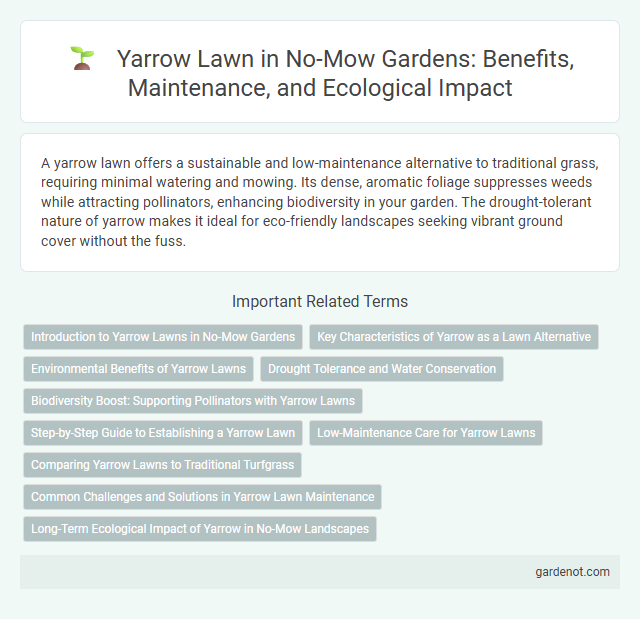A yarrow lawn offers a sustainable and low-maintenance alternative to traditional grass, requiring minimal watering and mowing. Its dense, aromatic foliage suppresses weeds while attracting pollinators, enhancing biodiversity in your garden. The drought-tolerant nature of yarrow makes it ideal for eco-friendly landscapes seeking vibrant ground cover without the fuss.
Introduction to Yarrow Lawns in No-Mow Gardens
Yarrow lawns offer a sustainable and low-maintenance alternative to traditional grass, thriving in no-mow gardens with minimal watering and soil enrichment. Known for their drought tolerance and vibrant green foliage with clusters of small white flowers, yarrow creates a resilient ground cover that supports pollinators and improves soil health. This hardy perennial requires little mowing, making it an ideal choice for eco-friendly landscapes and water-wise gardening.
Key Characteristics of Yarrow as a Lawn Alternative
Yarrow lawn features fine-textured, feathery foliage with clusters of small, white to pale pink flowers that attract pollinators, enhancing biodiversity. This drought-tolerant plant thrives in poor soils and requires minimal maintenance, making it a sustainable no-mow lawn alternative. Yarrow's natural pest-repellent properties reduce the need for chemical treatments, promoting an eco-friendly landscape solution.
Environmental Benefits of Yarrow Lawns
Yarrow lawns enhance biodiversity by providing habitat and food sources for pollinators such as bees and butterflies, promoting a balanced ecosystem. Their deep root systems improve soil health through aeration and water retention, reducing erosion and runoff. Yarrow also requires minimal mowing, which lowers carbon emissions and decreases reliance on chemical fertilizers and pesticides.
Drought Tolerance and Water Conservation
Yarrow lawn thrives in drought-prone areas due to its deep root system that efficiently stores water, reducing irrigation needs by up to 50%. Its drought tolerance makes it an ideal choice for sustainable landscaping, conserving water while maintaining green coverage throughout dry seasons. Integrating yarrow in no-mow lawns supports environmental stewardship by minimizing water usage and promoting resilient, low-maintenance turf alternatives.
Biodiversity Boost: Supporting Pollinators with Yarrow Lawns
Yarrow lawns enhance biodiversity by providing critical habitat and nectar sources for pollinators such as bees, butterflies, and beneficial insects. Their drought-resistant nature and dense foliage reduce the need for mowing and chemical treatments, creating an eco-friendly environment that supports a flourishing ecosystem. This no-mow lawn alternative attracts beneficial pollinators, promoting plant health and increasing local biodiversity.
Step-by-Step Guide to Establishing a Yarrow Lawn
Establishing a yarrow lawn involves preparing well-drained, poor soils by removing existing grass and weeds, followed by sowing yarrow seeds in early spring for optimal germination. Regular watering is essential during the first few weeks to promote strong root development, while minimizing mowing encourages dense, low-maintenance coverage. Over time, yarrow's drought tolerance and pest resistance make it an eco-friendly alternative to traditional grass lawns, requiring minimal upkeep and supporting local pollinators.
Low-Maintenance Care for Yarrow Lawns
Yarrow lawns require minimal irrigation and thrive in well-drained soil, making them ideal for low-maintenance landscapes. Their drought-resistant qualities reduce the need for frequent watering and mowing, saving time and resources. Regularly trimming spent flowers encourages a tidy appearance without intensive lawn care.
Comparing Yarrow Lawns to Traditional Turfgrass
Yarrow lawns require significantly less water and maintenance compared to traditional turfgrass, making them a sustainable alternative for eco-friendly landscaping. Their deep root systems improve soil health and promote biodiversity, unlike traditional turfgrass that often necessitates frequent mowing and chemical treatments. Yarrow also offers drought tolerance and natural pest resistance, reducing the need for irrigation and pesticides commonly associated with conventional lawns.
Common Challenges and Solutions in Yarrow Lawn Maintenance
Yarrow lawns often face challenges such as uneven growth and susceptibility to drought due to their shallow root systems, requiring careful irrigation management and periodic trimming to maintain uniformity. Weed invasion is another common issue, mitigated by dense planting and the application of organic mulches that enhance soil health. Pest control in yarrow lawns benefits from natural predators and neem-based treatments, reducing pesticide reliance and promoting sustainable maintenance practices.
Long-Term Ecological Impact of Yarrow in No-Mow Landscapes
Yarrow in no-mow lawns significantly enhances soil health by improving nutrient cycling and moisture retention through its deep root system. Its dense growth suppresses weeds, reducing the need for chemical herbicides and promoting biodiversity by providing habitat and nectar for pollinators like bees and butterflies. Over time, yarrow contributes to a resilient, low-maintenance landscape that supports ecological balance and reduces environmental footprints compared to traditional turfgrass.
Yarrow lawn Infographic

 gardenot.com
gardenot.com